|
|
|
Sort Order |
|
|
|
Items / Page
|
|
|
|
|
|
|
| Srl | Item |
| 1 |
ID:
165069
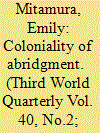

|
|
|
|
|
| Summary/Abstract |
This article examines processes of knowledge production around mass violence in 1970s Cambodia including media reportage and coeval scholarly debate, developing a conceptualisation of colonial abridgment. It assesses operations by which Cambodia as a country is violently essentialised, the occurrence of mass violence taking on metonymic grandeur that works to deny imperial legacies, entomb modern Cambodia in a hermetically sealed past and thereby maintain global order within existing racial-colonial logics.
|
|
|
|
|
|
|
|
|
|
|
|
|
|
|
|
| 2 |
ID:
156705


|
|
|
|
|
| Summary/Abstract |
Transfer and redistribution of wealth accompany most violent conflicts throughout the world, yet the local-level political and economic effects of this phenomenon remain unexplored. We address this omission by examining the long-term impact on the surrounding communities of the Nazi death camp Treblinka in Poland, where nearly a million Jews were murdered. The assets of murdered Jews sometimes ended up in the hands of the local population. We are able to identify the enduring impact of these property transfers on local economic and political outcomes because the exact location of Treblinka was exogenous to the characteristics of surrounding communities. We find that communities located closer to the camp experienced a real estate boom but do not exhibit higher levels of economic and social development. These communities also showed higher support for an anti-Semitic party, the League of Polish Families. Our findings speak to an important but overlooked challenge to post-conflict reconstruction and reconciliation.
|
|
|
|
|
|
|
|
|
|
|
|
|
|
|
|
| 3 |
ID:
115034
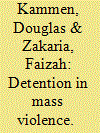

|
|
|
|
|
| Publication |
2012.
|
| Summary/Abstract |
This article examines the formulation and implementation of Indonesian Army policy regarding the detention of communists and other leftists in Indonesia from 1965 to 1968. The article highlights the relationship between the two primary forms of violence-killings and detentions-in the aftermath of the failed September 30th Movement. Placing detentions at the center of analysis changes our understanding of the mass violence in several ways. First, it demonstrates that the policy to detain and "classify" large numbers of suspected communists helped to fuel the attack on the political Left. Second, it shifts the locus of analysis away from identification of the perpetrators and victims and instead seeks to highlight the processes that enabled and shaped the violence. Third, by examining the ratio between the estimated number of individuals killed and the number of individuals who remained alive in detention at a particular point in time, the article proposes a new explanation for variation in the scale and intensity of mass violence across Indonesia. This analysis encourages comparison across a much wider range of cases within Indonesia than has previously been attempted and provides a framework for future work on the mass violence in Indonesia as well as in other cases in which mass detentions or forced relocations preceded mass killings.
|
|
|
|
|
|
|
|
|
|
|
|
|
|
|
|
| 4 |
ID:
175816
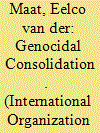

|
|
|
|
|
| Summary/Abstract |
Under conditions of guerrilla conflict, mass indiscriminate violence has been shown to effectively starve a guerrilla of its support. Consequently, counter-guerrilla mass violence is concentrated within territories where a guerrilla is dominant. However, in roughly 40 percent of mass violence episodes (e.g., Rwanda and Cambodia), the violence was aimed at populations within areas of secure territorial control. These episodes have therefore been explained by attributing ideological preferences to leaders or as unique cases only. I argue that leaders adopt mass indiscriminate violence against outgroups to consolidate power under conditions of elite rivalry. The violence serves two main goals. First, it helps build coalitions with constituencies that gain from violence; and second, it targets rival factions indirectly by forcing local security officials to facilitate or oppose the violence. The violence thereby provides rival supporters with an exit option, provides the regime with information on rival supporters’ private loyalties, and undermines rivals’ abilities to mount an effective resistance. These rivals can ultimately be purged from the regime. Based on newly collected original data on elite purges and on the type of mass indiscriminate violence for the years 1950 to 2004, I show that this type of mass violence, which I call “genocidal consolidation,” is intimately connected to authoritarian consolidation.
|
|
|
|
|
|
|
|
|
|
|
|
|
|
|
|
| 5 |
ID:
145681
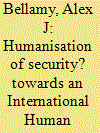

|
|
|
|
|
| Summary/Abstract |
Over the past few decades, genocidal killing and other mass atrocities have become less frequent and less lethal. At the same time, collective international responses have become more common and more comprehensive. What explains these two phenomena, and are they connected? This article suggests that the evidence of declining mass violence and growing international activism is not only compelling but that the two phenomena are connected by the emergence of a new international human protection regime. The article proceeds in three parts. The first examines the evidence for thinking that the world is experiencing both a decline in mass violence and an increase in international activism in response to such violence. The second outlines the emergence, scope, and limits of the human protection regime. The third considers whether the regime itself is associated with the changing practices of third parties to mass violence. The fourth part contrasts this explanation with potential alternatives.
|
|
|
|
|
|
|
|
|
|
|
|
|
|
|
|
| 6 |
ID:
103126
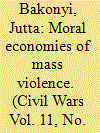

|
|
|
|
|
| Publication |
2009.
|
| Summary/Abstract |
The focus in the article is on the beginning and expansion of the Somali war between 1988 and 1992. Three patterns and dynamics of mass-mobilisation are comparatively examined: the relatively sudden transformation of the northern guerrilla struggle in a civil war 1988, the expansion of the war to the southern region after 1989 and the mass-upheaval in Mogadishu 1990/91. Although clan-affiliation became a prominent tool to mobilising violence and to framing friends and foes throughout Somalia, the patterns of organising clan-relations within the insurgent movements and between the movements and the non-armed population differed and laid the basis for the different trajectories of violence in the Somali regions.
|
|
|
|
|
|
|
|
|
|
|
|
|
|
|
|
| 7 |
ID:
168434
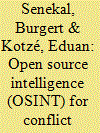

|
|
|
|
|
| Summary/Abstract |
With the advent of the information age, Open Source Intelligence (OSINT) has gained special prominence in the Intelligence Community (IC). However, the era of big data has brought numerous challenges in handling OSINT, in particular because big data comprise large volumes of unstructured data that are generated continuously. In this article, we discuss the use of OSINT in the era of big data, in particular how it relates to compiling event data, but also show that large projects with an international focus such as the Integrated Crisis Early Warning System (ICEWS) are inadequate to study political instability in the current South African context. We shift our collection efforts from mainstream media to the analysis of WhatsApp messages, since this platform has recently gained popularity and it is widely used in South Africa. We show how we build an automated data pipeline that provides near real time data on the occurrence of mass violence in South Africa. For this analysis, we make use of Natural Language Processing (NLP) toolkits in Python and build interactive dashboards to monitor the state of mass violence in South Africa.
|
|
|
|
|
|
|
|
|
|
|
|
|
|
|
|
| 8 |
ID:
114744


|
|
|
|
|
| Publication |
2012.
|
| Summary/Abstract |
The proclaimed function of the Shanghai Cooperation Organisation (SCO) is regional security management. Nonetheless, it has never conducted a conventional peacekeeping operation, in spite of incidents of mass violence and instability within its region. This is in large part because regional elites consider state/regime security as paramount and that the SCO's central principle of non-interference takes precedence over intervention on humanitarian grounds. This article investigates the debate within the SCO about the relative salience of non-interference against the need for peacekeeping operations, examining the case of its non-action during the Osh Riots 2010. It concludes that considerations of political reassurance and inter-regime mistrust at a regional level and serious practical limitations in capacity dissuaded the most prominent member states from acting, via the SCO, Collective Security Treaty Organisation or independently, in what was perceived as an internal Kyrgyz affair because it did not directly threaten the security of the other members' regimes.
|
|
|
|
|
|
|
|
|
|
|
|
|
|
|
|
| 9 |
ID:
132172
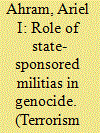

|
|
|
|
|
| Publication |
2014.
|
| Summary/Abstract |
This article explains how and why armed, non-state actors collaborate with states to inflict massive levels of violence. Regime type and state capacity interact to provide state elites a menu of repertoires for implementing violence, some emphasizing direct state action, others emphasizing cooperation and alliance between state and armed, non-state actors. Rather than struggling in vain to build strong states to eliminate armed non-state actors and establish a monopoly over the use of force, averting genocide might necessitate recruiting and strengthening the power of indigenous, armed non-state actors.
|
|
|
|
|
|
|
|
|
|
|
|
|
|
|
|
| 10 |
ID:
098084
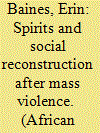

|
|
|
|
|
| Publication |
2010.
|
| Summary/Abstract |
A vibrant debate in the field of transitional justice concerns the relative ability of global, national, and local mechanisms to promote justice after violent conflict. Discussion largely focuses on more formal mechanisms of justice (courts, tribunals, or truth commissions), implying that state institutions and the law are solely responsible for shaping the process of social healing. This article suggests that scholars should take seriously more informal, socio-cultural processes outside the purview of the state, particularly for how they promote social reconstruction at the micro level. Examining the phenomena of spirit possession and ritual cleansing in northern Uganda, I illustrate how such efforts are expressions of injustice and reflect ordinary people's attempts to seek moral renewal and social repair. This approach is particularly illustrative in cases where 'intimate enemies' exist - that is, settings where ordinary people who engaged in violence against one another must live together again.
|
|
|
|
|
|
|
|
|
|
|
|
|
|
|
|
| 11 |
ID:
107043
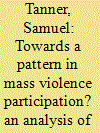

|
|
|
|
|
| Publication |
2011.
|
| Summary/Abstract |
In this article, I focus on the logic whereby a group of eight Hutu became involved in mass violence during the 1994 Rwandan genocide. This process is considered as a sequence of meaningful events that progressively shaped the actors' frame of analysis. As such, each sequence brings a new qualitative reality which, in turn, constitutes the platform upon which the involvement in, and the perpetration of, mass violence become acceptable and legitimate in the eyes of the perpetrators. Based on both Howard S. Becker's notion of career and Roger Petersen's analysis of resistance and rebellion, I disaggregate the entire process of participation in mass violence into a sequence of six mechanisms, generating two main phases. The first one, mobilisation, refers to the movement from a neutral state to a mobilised state. The second phase, collective action, covers the drift from mobilisation to action, namely, killings.
|
|
|
|
|
|
|
|
|
|
|
|
|
|
|
|
| 12 |
ID:
158213
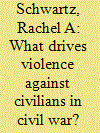

|
|
|
|
|
| Summary/Abstract |
Dominant theories of mass violence hold that strategic concerns in civil war drive the deliberate targeting of civilians. However, the causal mechanisms that link strategic objectives to large-scale violence against civilians remain underspecified, and as such the causal logics that underpin each remain blurred. In this article, we identify and explicate four plausible mechanisms that explain why armed groups would target, for strategic purposes, civilians in war. We then turn to the peak period of violence during the Guatemalan armed conflict to assess which mechanisms were most prevalent. Specifically, we leverage unique archival data: 359 pages of military files from Operation Sofía, a month-long counterinsurgent campaign waged in the northwestern Ixil region. Through process tracing of real-time internal communications, we find that state actors most commonly described the civilian population as loyal to rebel forces; violence against civilians was a means to weaken the insurgency. Troops on the ground also depicted the Ixil population as ‘winnable’, which suggests that security forces used violence in this period to shape civilian behavior. These findings are most consistent with the idea that mass violence in this case and period was a coercive instrument to defeat insurgents by punishing civilians for collaboration. The evidence from this period is less consistent with a logic of genocide, in which the purpose of violence would be to destroy ‘unwinnable’ civilian groups. Our analysis illustrates how a mechanism-centered approach based on process tracing of conflict archives can help uncover logics underlying civilian killing.
|
|
|
|
|
|
|
|
|
|
|
|
|
|
|
|
|
|
|
|
|